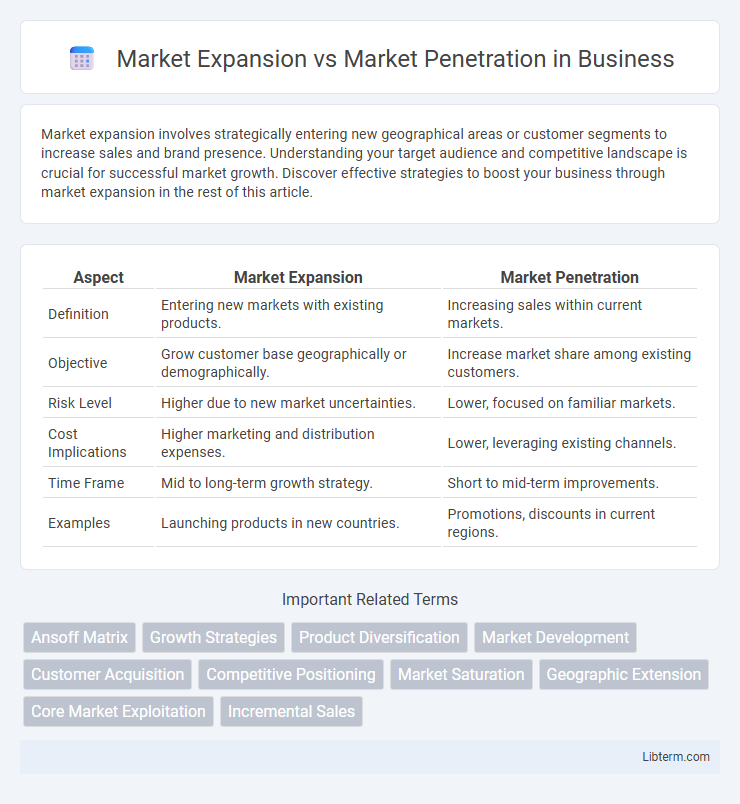Market expansion involves strategically entering new geographical areas or customer segments to increase sales and brand presence. Understanding your target audience and competitive landscape is crucial for successful market growth. Discover effective strategies to boost your business through market expansion in the rest of this article.
Table of Comparison
| Aspect | Market Expansion | Market Penetration |
|---|---|---|
| Definition | Entering new markets with existing products. | Increasing sales within current markets. |
| Objective | Grow customer base geographically or demographically. | Increase market share among existing customers. |
| Risk Level | Higher due to new market uncertainties. | Lower, focused on familiar markets. |
| Cost Implications | Higher marketing and distribution expenses. | Lower, leveraging existing channels. |
| Time Frame | Mid to long-term growth strategy. | Short to mid-term improvements. |
| Examples | Launching products in new countries. | Promotions, discounts in current regions. |
Introduction to Market Expansion and Market Penetration
Market expansion involves entering new geographical areas or targeting new customer segments to increase a company's reach and revenue streams. Market penetration focuses on increasing sales of existing products within the current market by enhancing market share through competitive pricing, promotions, and improved product visibility. Both strategies are essential for sustainable business growth and require distinct approaches based on company goals and market conditions.
Defining Market Expansion
Market expansion involves entering new geographic regions or targeting new customer segments to increase a company's market reach and revenue potential. This strategy requires adapting marketing approaches, developing new distribution channels, or offering modified products to meet diverse consumer needs. Market expansion contrasts with market penetration, which aims to boost sales within existing markets by increasing product usage or acquiring competitors.
Understanding Market Penetration
Market penetration measures the extent to which a product or service is bought by customers in an existing market, highlighting its current market share compared to competitors. Strategies to increase market penetration often involve pricing adjustments, promotional campaigns, and enhancing product availability to boost customer acquisition and retention. Companies prioritizing market penetration seek to maximize sales within established markets before considering expansion into new geographic or demographic segments.
Key Differences Between Market Expansion and Penetration
Market expansion involves entering new geographic regions or customer segments to increase revenue, while market penetration focuses on increasing sales within existing markets by capturing a larger share of current customers. Market expansion demands significant investment in research, marketing, and distribution channels to adapt products for new audiences, unlike market penetration, which primarily leverages competitive pricing, promotions, and improved customer engagement strategies. The key difference lies in market expansion targeting new demand creation, whereas market penetration aims to maximize sales from existing demand.
Benefits of Market Expansion Strategies
Market expansion strategies enable businesses to enter new geographic regions or target different customer segments, significantly increasing their potential revenue streams and market share. Expanding into untapped markets reduces reliance on existing customers, diversifies business risk, and enhances brand recognition across broader demographics. Companies leveraging market expansion can achieve sustainable growth by capitalizing on new consumer demands and competitive advantages in emerging markets.
Advantages of Market Penetration Approaches
Market penetration strategies increase a company's share within existing markets by leveraging established customer bases, minimizing risks and costs associated with entering new markets. These approaches enhance brand loyalty and encourage repeat purchases through targeted marketing and pricing tactics, leading to steady revenue growth. Strong market penetration also strengthens competitive positioning, making it difficult for rivals to capture market share.
Challenges in Market Expansion
Market expansion faces challenges such as cultural differences, regulatory compliance, and increased operational costs, which can hinder entry into new geographic or demographic markets. Companies must navigate unfamiliar market dynamics, including local consumer behavior and competitive landscapes, requiring tailored marketing strategies and adaptation. Managing supply chain complexities and establishing brand trust in new territories are critical obstacles impacting the success of market expansion initiatives.
Risks Associated with Market Penetration
Market penetration strategies often carry risks such as market saturation, which limits growth opportunities and reduces profit margins due to intense competition. There is also the possibility of aggressive price wars that can erode brand value and financial stability. Furthermore, over-reliance on existing markets increases vulnerability to changing consumer preferences and economic downturns, impacting overall business resilience.
Choosing the Right Growth Strategy
Selecting the optimal growth strategy depends on evaluating market expansion and market penetration based on business goals and resources. Market penetration emphasizes increasing sales within existing markets by enhancing product adoption, pricing strategies, or promotional efforts. Market expansion targets entering new markets or segments to diversify customer base and reduce dependency on current markets, demanding thorough market research and risk assessment.
Case Studies: Market Expansion vs Market Penetration
Case studies reveal that market expansion strategies, such as Netflix's entry into international markets, leverage new customer segments and geographic areas to fuel growth. In contrast, market penetration examples like Coca-Cola intensify sales by increasing market share within existing markets through aggressive marketing and product differentiation. Firms achieve sustained competitive advantage by analyzing consumer behavior, competitive landscape, and scalability potential in each strategic approach.
Market Expansion Infographic

 libterm.com
libterm.com